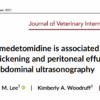This is a quick FASTVet Original and FREE Resource for understanding Vet BLUE® lung ultrasound and its regional, pattern-based approach for lung evaluation. Use our format and never “flash ultrasound lung”, which leads to major mistakes. Note there are many more resources available through our FASTVet Premium Membership.
Ettinger 9th Edition Webinar Shorts – 02 Vet BLUE® Its Acronym and How to Perform Its Views
The fundamental orientation for Vet BLUE® and all lung ultrasound is our Gator Sign Orientation with 2 ribs and an interposing intercostal space where the lung surface called the “Lung Line” is expected.
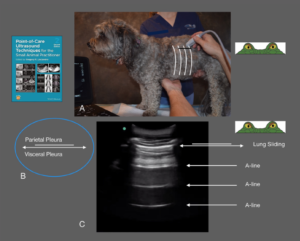
Figure. Gator Sign Orientation. The rounded ribs are likened to the eyes, and the bright white hyperechoic “Lung Line” or “pulmonary-pleural interface” in between ribs in the intercostal space (ICS) likened to the bridge of its nose as a partially submerged alligator (gator) peers at the sonographer. This orientation is fundamental for ALL lung ultrasound to ensure one accurately identifies where lung is expected to be in normalcy, referred to as the “Lung Line”, along the ICS. This material is reproduced with permission of John Wiley & Sons, Inc., Point-of-Care Ultrasound Techniques for the Small Animal Practitioner, 2nd Edition, Wiley ©2021 and FASTVet.com © 2014, 2021.
The Vet BLUE® – Its 9 Acoustic Windows
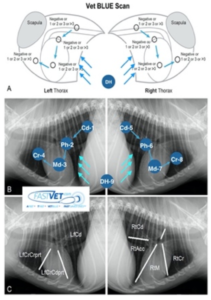
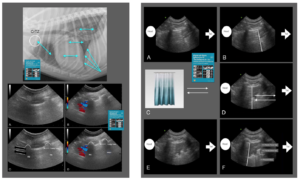
Figure. Caudal and Cranial Vet BLUE® Transition Zones. The composite to the left is the cranial transition zone found by sliding along the “Lung Line” until it ends in the soft tissue of the thoracic inlet with its jugular and carotid vessels. The caudal transition zone is identified by the “Curtain Sign of lung ultrasound” and the linear border of air that identifies the pleural cavity to the left and the abdominal cavity to the right. Recall our mantra, “make everything spatially like a lateral radiograph.” This material is reproduced with permission of John Wiley & Sons, Inc., Point-of-Care Ultrasound Techniques for the Small Animal Practitioner, 2nd Edition, Wiley ©2020 and FASTVet.com © 2014, 2020.
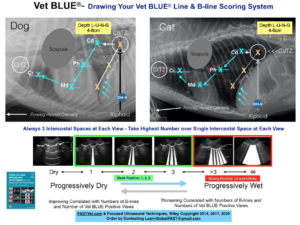
Figure. Selecting the Vet BLUE® Line and Vet BLUE® B-line Scoring. This material is reproduced with permission of John Wiley & Sons, Inc., Point-of-Care Ultrasound Techniques for the Small Animal Practitioner, 2nd Edition, Wiley ©2021 and Greg Lisciandro, Hill Country Veterinary Specialists, FASTVet.com © 2014, 2020.
How to Perform. The Vet BLUE® begins at the CTS view of TFAST® and establishing the “Gator Sign” orientation. The probe is then moved through regional views that are bilaterally applied as follows: caudodorsal lung region, perihilar lung region, middle lung region, and lastly the cranial lung region. The caudodorsal transition zone (CdTZ) is located by starting directly above the xiphoid in the upper third of the thorax and locating the “Curtain Sign of lung ultrasound” that differentiates the pleural from abdominal cavities. If it is not immediately located, the probe is generally slid caudally searching for obvious abdominal structures and then sliding cranially finding the “Curtain Sign of lung ultrasound.” The principle is very important because abdominal structures are easily mistaken for lung pathology without this training.
Once the CdTZ is located, the probe is slid 3 intercostal spaces (ICS) cranially and away from the CdTZ. While sliding away from the CdTZ lung can be evaluated for pathology since the sonographer knows they are in fact over the pleural cavity. The location 3 ICS away from the CdTZ is considered the starting point. Its ICS is surveyed and then the sonographers slides one space caudally over its ICS, returns to the primary ICS and then moves one more ICS cranially so that a minimum of 3 ICSs are interrogated at the caudodorsal lung region. A line, referred to as the “Vet BLUE® Line” is then drawn with the coupling medium from the caudodorsal starting point to the patient’s elbow. Approximately halfway to the elbow is the perihilar region and at the level of the elbow is the middle lung region, using the heart as a reference point (sliding immediately dorsal to the heart). The methodology is repeated as done previously, i.e., interrogating the primary ICS, sliding caudally, and interrogating its ICS, before returning to the primary and sliding one ICS cranially, imaging a minimum of 3 ICSs. The cranial lung region is imaged a differently by finding the cranial cervical transition zone (CrTZ) by following the “Lung Line” until it drops off into the soft tissue of the thoracic inlet. The imaging course for the Vet BLUE® is like a check mark, meaning as the sonographer slides cranial-dorsal into the thoracic inlet. Assurance of being in the thoracic inlet is made by the presence of parallel pulsating arteries from the costocervical trunk with a rib shadow immediately caudal followed by the “Gator Sign” and a “Lung Line.” The 3 ICSs at the cranial lung region are performed by sliding from the thoracic inlet and then counting “first rib, first ICS, second rib, second ICS, third rib, third space.” Additional FASTVetTM Vet BLUE® and TFAST® Rules are 1) to always slide caudally first to always ask the question, “Where is the abdominal cavity?” and 2) if you do not have a “Gator Sign” orientation you cannot accurately assess lung. Always perform Vet BLUE® in this same order as findings are better remembered, starting left and finishing on the right if the patient allows.
Ettinger 9th Edition Webinar Shorts – 02 Vet BLUE® Its Acronym and How to Perform Its Views
We have found the most efficient Global FAST® protocol in a standing patient is beginning with the left Vet BLUE® and then moving to the left TFAST® Pericardial Site followed by a standing AFAST® and Focused Spleen before moving to the right Vet BLUE®, right Pericardial Site and its TFAST® echocardiography views, and ending on the AFAST® Hepato-Renal 5th Bonus View. A video may be found in the Free Resources of the FASTVet.com website by clicking here.
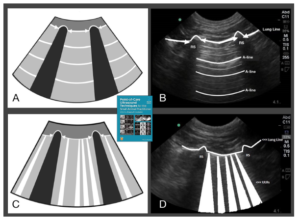
How to use our FASTVet original and unique Vet BLUE® Regional, Pattern-based Approach for a rapid working diagnosis and as a complement for lung radiography (LXR) and Vet BLUE® has many advantages over LXR. Vet BLUE® is the best lung ultrasound format from a practical approach as a screening test and does quite well from a comprehensive lung ultrasound format in that a large area of lung is surveyed.
Figure. Wet versus Dry Lung. “Dry Lung” is defined as A-lines with “Lung Sliding.” “Wet Lung” is defined as B-lines with hyperechoic laser like vertical streaks that obliterate A-lines while swinging like a pendulum in respirophasic synchrony. If they don’t follow this rule, then they are not B-lines also called “Lung Rockets.” This material is reproduced with permission of John Wiley & Sons, Inc., Point-of-Care Ultrasound Techniques for the Small Animal Practitioner, 2nd Edition, Wiley ©2021 and Greg Lisciandro, Hill Country Veterinary Specialists, FASTVet.com © 2014, 2021.
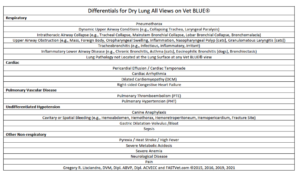
Table. Vet BLUE® Dry Lung ALL Views. The most rapid and sensitive way to rule out “Wet Lung” conditions is the finding of “Dry Lung ALL Vet BLUE® views.” This may be the greatest clinical strength of Vet BLUE®. This material is reproduced with permission of John Wiley & Sons, Inc., Point-of-Care Ultrasound Techniques for the Small Animal Practitioner, 2nd Edition, Wiley ©2021 and Greg Lisciandro, Hill Country Veterinary Specialists, FASTVet.com © 2014, 2021.
The clinical impact of “Dry Lung ALL Vet BLUE® Views” should not be underestimated. It’s super fast (<60 seconds) and rules out all clinically relevant “Wet Lung” conditions. If you question “Dry Lung ALL Vet BLUE® Views”, merely repeat the Vet BLUE® in 2-4 hours or on the next recheck or patient rounds.
This is a FASTVet Original and unique Vet BLUE® veterinary B-line scoring system, divided into a “weak” and “strong” positive model. We expect rare single B-lines in cats and dogs and puppies and kittens over 6-weeks of age through our published clinical research. This is important because any number of B-lines should be placed into clinical context. As per Dr. Nilam Soni, MD, at the POCUS Workshop for human medicine (Austin, Texas, January 2024), “veterinarians probably have a better B-line scoring system (than we).” Our FASTVet Vet BLUE® B-line scoring system also has advantages in recording and comparing findings to future and past studies, and has an inherent severity scoring system – see below.

Figure. Vet BLUE® B-line Scoring System. Shown is our Vet BLUE® B-line Scoring System taking the maximum number of B-lines over a single intercostal space at each respective Vet BLUE® region and scoring as “0”, dry, and “1”, “2”, “3”, “>3”, and “infinity” as wet. The positive B-lines as further categorized as “weak” (1,2,3) and “strong” positives (>3 and infinity). This material is reproduced with permission of John Wiley & Sons, Inc., Point-of-Care Ultrasound Techniques for the Small Animal Practitioner, 2nd Edition, Wiley ©2021 and Greg Lisciandro, Hill Country Veterinary Specialists, FASTVet.com © 2014, 2021.
Vet BLUE® B-line Scoring System Volpicelli and colleagues (2006) showed that numbers of B-lines on LUS in people correlated with degree of alveolar- interstitial edema on the reference standard of computed tomography (CT). This is truly a remarkable finding because lung ultrasound (LUS) may be performed point-of-care, is rapid and radiation sparing, and time sensitive whereas CT is expensive, limited availability, risky for transport, restraint, and radiation exposure (CT comparable to 100 chest X-rays). We developed a Vet BLUE® B-line Scoring System taking the maximum number of B-lines over a single intercostal space at each respective Vet BLUE® region and scoring as “0”, dry, and “1”, “2”, “3”, “>3”, and “infinity” as wet. The positive B-lines as further categorized as “weak” (1,2,3) and “strong” positives (>3 and infinity).
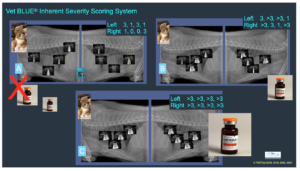
Figure. The Vet BLUE® B-line Severity Scoring System. The Vet BLUE® B-line Scoring System serves as an inherent severity scoring system and is used for tracking patients as static, worsening (A to C), improving (C to A), and complete resolution (“Dry All Vet BLUE® Views”). This material is reproduced with permission of John Wiley & Sons, Inc., Point-of-Care Ultrasound Techniques for the Small Animal Practitioner, 2nd Edition, Wiley ©2021 and Greg Lisciandro, Hill Country Veterinary Specialists, FASTVet.com © 2014, 2021.
Ettinger 9th Edition Webinar Shorts – 03 Vet BLUE® and Its B-line Scoring and Weak Positives Count!
Pseudo B-lines versus True B-lines
B-lines also called “Lung Rockets” most often represent “Wet Lung” however, there are mimics and 2 most common are nodules that are not wet, blood, water or pus cuffed by alveoli, but rather soft tissue cuffed by alveoli tat casts a B-line vertical artifact; and gastric ingest, that is cuffed by air, that also is cuffed by air similar to aerated alveoli, also results in casting a B-line vertical artifact. We believe it is best to call “Wet Lung” artifacts true B-line and those caused by something other than “Wet Lung” be called “Pseudo B-lines.” A 3rd cause of “Pseudo B-lines” would be atelectic lung.
The Probe Type Matters. Best to use a convex or linear probe and we do not recommend the use of a phased-array (cardiac) probe as you will see from this Blog based on a study we published in AJVR.
Figure. Vet BLUE® Visual Lung Language and Its 6 Signs. Vet BLUE® Visual Lung Language from most to least normal, from less severe to more severely affected lung. The Vet BLUE® echelon is “Dry Lung”, “Wet Lung” (alveolar-interstitial edema), Shred Sign (air bronchogram), Tissue Sign (hepatization of lung), “Nodule Sign”, “Wedge Sign” (pulmonary embolism/thromboembolism). The “Nodule Sign” and “Wedge Sign” were created and published by the speaker. This material is reproduced and modified with permission of John Wiley & Sons, Inc., Point-of-Care Ultrasound Techniques for the Small Animal Practitioner, Wiley ©2014, ©2021 and Greg Lisciandro, Hill Country Veterinary Specialists and FASTVet.com © 2021.
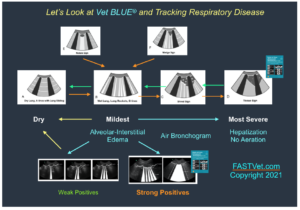 Figure. Use of Vet BLUE® for Tracking Respiratory Conditions. Once this flow chart is understood, the clinical can see how Vet BLUE® may be used to monitor any respiratory conditions. This material is reproduced and modified with permission of John Wiley & Sons, Inc., Point-of-Care Ultrasound Techniques for the Small Animal Practitioner, Wiley ©2014, ©2021 and Greg Lisciandro, Hill Country Veterinary Specialists and FASTVet.com © 2021.
Figure. Use of Vet BLUE® for Tracking Respiratory Conditions. Once this flow chart is understood, the clinical can see how Vet BLUE® may be used to monitor any respiratory conditions. This material is reproduced and modified with permission of John Wiley & Sons, Inc., Point-of-Care Ultrasound Techniques for the Small Animal Practitioner, Wiley ©2014, ©2021 and Greg Lisciandro, Hill Country Veterinary Specialists and FASTVet.com © 2021.
Vet BLUE® Scoring System Use for Guiding Diuretic Usage The Vet BLUE® B-line Scoring System is used for guiding loop diuretics in left-sided congestive heart failure (Murphy et al. JVIM 2021). Vet BLUE® serves as a tool for guiding loop diuretic therapy over 3-view thoracic radiography (Ward, Lisciandro, DeFrancesco JVECC 2018) and thus preventing their many side effects of metabolic alkalosis, hemoconcentration, and renal injury and failure.
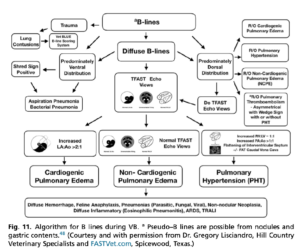
Algorithm. Integration of Vet BLUE® and TFAST® Echocardiography and Caudal Vena Cava. The algorithm shows integration of TFAST® echocardiography and caudal vena cava findings when B-lines are present during Vet BLUE®. This material is reproduced and modified with permission of John Wiley & Sons, Inc., Point-of-Care Ultrasound Techniques for the Small Animal Practitioner, Wiley ©2014, ©2021 and Greg Lisciandro, Hill Country Veterinary Specialists and FASTVet.com © 2021.

Algorithm. Vet BLUE® Signs and their Distribution for a Working Diagnosis. The algorithm shows the various Vet BLUE® findings and rule outs. This material is reproduced and modified with permission of John Wiley & Sons, Inc., Point-of-Care Ultrasound Techniques for the Small Animal Practitioner, Wiley ©2014, ©2021 and Greg Lisciandro, Hill Country Veterinary Specialists and FASTVet.com © 2021.
Some FASTVetTM Webinars
- The Power of TFAST® – Using Ultrasound to Support a Higher Standard of Patient Care here.
- Vet BLUE® and TFAST® for Common Respiratory Conditions in Cats – ACVIM Forum 2022 here.
- Use of Vet BLUE® for Small Animal Pneumonia and Relevance to COVID-19 – ACVIM Forum 2022 here.
- TFAST® for Pulmonary Hypertension – Pearls and Pitfalls here.
- Left Atrial Tear (Rupture) – A Complication You Will See here.
- TFAST® Echo Views Pearls and Pitfalls here.
- The Tale of 4 Felines – Use of TFAST® and Vet BLUE® here.
References & Further Reading
- Figures and Tables for these TFAST® Proceedings are here.
- FASTVetTM Free Resources here; Goal-directed Templates here; Webinars here; Global FAST® Training here; Video How to Perform Global FAST® Efficiently here; Anaphylactic Hemoabdomen Webinar in Dogs here; other Free Resources here.
- Point-of-care Ultrasound Techniques for the Small Animal Practitioner, 2nd edition, Ed. Lisciandro GR, Wiley ©2021. Click here.
- Lisciandro GR, Lisciandro SC. Chapter 22: POCUS: Vet BLUE-Introduction and Image Acquisition. In Point-of-care Ultrasound Techniques for the Small Animal Practitioner, 2nd Edition, Ed. Lisciandro GR. Wiley Blackwell: Ames IA 2021.
- Lisciandro GR, Lisciandro SC. Chapter 23: POCUS: Vet BLUE-Clinical Integration. In Point-of-care Ultrasound Techniques for the Small Animal Practitioner, 2nd Edition, Ed. Lisciandro GR. Wiley Blackwell: Ames IA 2021.
- Lisciandro GR. Chapter 36: POCUS: Global FAST-Patient Monitoring and Staging. In Point-of-care Ultrasound Techniques for the Small Animal Practitioner, 2nd Edition, Ed. Lisciandro GR. Wiley Blackwell: Ames IA 2021.
- Lisciandro GR, Puchot ML, Gambino JM, Lisciandro SC. The Wedge Sign: A Possible Lung Ultrasound Sign for Pulmonary Thromboembolism. J Vet Emerg Clin Care 2021.
- Ward JL, Murphy SD, Lisciandro GR, et al. Comparison of curvilinear-array (microconvex) and phased-array transducers for ultrasonography of the lungs in dogs. Am J Vet Res 2021.
- Lisciandro GR, Lagutchik MS, Mann KA, et al. Evaluation of a thoracic focused assessment with sonography for trauma (TFAST) protocol to detect pneumothorax and concurrent thoracic injury in 145 traumatized dogs. J Vet Emerg Crit Care 2008; 18(3):258.
- Lisciandro GR. Abdominal (AFAST) and thoracic (TFAST) focused assessment with sonography for trauma, triage, and tracking (monitoring) in small animal emergency and critical care. J Vet Emerg Crit Care 2011; 21(2): 104-119.
- Lisciandro GR, Fosgate GT, Fulton RM, et al. Frequency and number of ultrasound lung rockets (B-lines) using a regionally based lung ultrasound examination named Vet BLUE (veterinary bedside lung ultrasound exam) in dogs with radiographically normal lung findings. Vet Radiol and Ultrasound 2014;55(3): 315-22.
- Lisciandro GR, Fulton RM, Fosgate GT, et al. Frequency and number of ultrasound lung rockets (B-lines) using a regionally based lung ultrasound examination named Vet BLUE (veterinary bedside lung ultrasound exam) in cats with radiographically normal lung findings. J Vet Emerg Crit Care 2017; 27(3):267-277.
- Ward JL, Lisciandro GR, Tou SP, Keene BW, DeFrancesco TC. Accuracy of point-of-care lung ultrasound (Vet BLUE protocol) for the diagnosis of cardiogenic pulmonary edema in dogs and cats with acute dyspnea. J Am Vet Med Assoc 2017 250(6): 566-579.
- Ward JL, Lisciandro GR, DeFrancesco TD, et al. Evaluation of Point-of-care Thoracic Ultrasound and NT-proBNP for the Diagnosis of Congestive Heart Failure in Cats with Respiratory Distress. J Vet Intern Med 2018; 32(5):1530-1540.
- Ward JL, Lisciandro GR, Ware WA, Miles KG, DeFrancesco TC. Lung ultrasound findings in 100 dogs with various etiologies of cough. J Am Vet Med Assoc 2019;255(5): 574-583.
- Lisciandro GR, Ward JL, DeFrancesco TC, Mann KA. Absence of B-lines on Lung Ultrasound (Vet BLUE protocol) to Rule Out Left-sided Congestive Heart Failure in 368 Cats and Dogs. Abstract, J Vet Emerg Crit Care 2016; 26(S1): S8.
- Ward JL, Lisciandro GR, DeFrancesco TC. Distribution of alveolar-interstitial syndrome in dyspneic veterinary patients assessed by lung ultrasound versus thoracic radiographs. J Vet Emerg Crit Care, 2018;28(5):415-428.
- Dicker SA, Lisciandro GR, Newell SM, et al. Diagnosis of pulmonary contusions with point-of-care lung ultrasonography and thoracic radiography compared to thoracic computed tomography in dogs with motor vehicle trauma: 29 cases (2017-2018). J Vet Emerg Crit Care 2021.
- Lisciandro GR. Chapter 55: Ultrasound in Animals. In Critical Care Ultrasound (human textbook), Editors Lumb and Karakitsos. Elsevier: St. Louis, MO 2014.
- Rademacher N, Pariaut R, Pate J, et al. Transthoracic lung ultrasound in normal dogs and dogs with cardiogenic pulmonary edema: a pilot study. Vet Radiol Ultrasound 2014; 55(4):447–52.
- Hwang TS, Yoon YM, Jung DI, Yeon SC, Lee HC. Usefulness of transthoracic lung ultrasound for the diagnosis of mild pneumothorax. J Vet Sci 2018;19(5):660–666.
- Vezzosi T, Mannucci T, Pistoresi A et al. Assessment of lung ultrasound B-lines in dogs with different stages of chronic valvular heart disease. J Vet Intern Med 2017;31(3):700–704.
- Armenise A, Boysen S, Rudloff E, et al. Veterinary focused assessment sonography for trauma (Vet- FAST)—airway, breathing, circulation, disability and exposure (ABCDE)—in 64 canine trauma patients. J Small Anim Pract. 2019;60(3):173–182.
- Lichtenstein D, Mesiere G, Biderman P, Gepner A. The lung point: an ultrasound sign specific to pneumothorax. Intensive Care Med 2000;26:1434–1440.
- Lichtenstein D, Mesiere G, Biderman P, Gepner A. The lung pulse: an ultrasound sign of complete atelectasis. Intensive Care Med 2003;29:1930–1939.
- Nazerian P, Volpicilli G, Vanni S, et al. Accuracy of lung ultrasound for the diagnosis of consolidations when compared to chest computed tomography. Am J Emerg Med 2015;33:620–625.
- Kulhavy DA, Lisciandro GR. Use of a Lung Ultrasound Examination Called Vet BLUE to Screen for Metastatic Lung Nodules in The Emergency Room. Abstract, J Vet Emerg Crit Care 2015; 25(S1);S14.
- Pacholec C, Lisciandro GR, Masseau I, et al. Lung ultrasound nodule sign for detection of pulmonary nodule lesions in dogs: Comparison to thoracic radiography using computed tomography as the criterion standard. Vet J 2021 Jul 31;105727.doi: 10.1016/j.tvjl.2021.105727. Online ahead of print.
- Lisciandro GR. Evaluation of initial and serial combination focused assessment with sonography for trauma (CFAST) examination of the thorax (TFAST) and abdomen (AFAST) with the application of an abdominal fluid scoring system in 49 traumatized cats. Abstract, J Vet Emerg Crit Care 2012; 22(2): S11.
*A summary of all our 20+ peer-reviewed clinical studies may be found here.
gl/GL 4-9-2024




